The city of Ephesus is located on the western coast of Turkey near the modern city of Selcuk (Seljuk) in the area known as Anatolia. Although today it is 10 KM from the coast, in ancient times it was a seacoast city with a busy commercial harbor, with a population of over 250,000 people. During Roman times it had become the capital of the Province of Asia controlling over 500 Anatolian towns. The great Temple of Artemis (Diana) at Ephesus was one of the Seven Wonders of the Ancient World, but most of what remains of this famous temple is housed in the British Museum today.
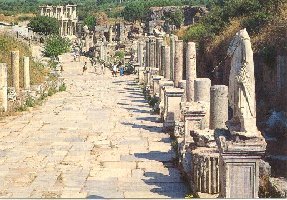 Curetes Street |
Today, the view down Curetes Street is still one of the most awe-inspiring in what remains of the city. This street was once lined with temples, monuments, fountains, statues, houses of the wealthy, public rest rooms, and expensive shops. Curetes Street offered a pleasant view from the Panayir Mountain before it arrived at the Mazeus Gate and Main Square of the city at the meeting point of the hills. Today, although only facades, partly standing walls, and broken statuary remains, it is still remains an impressive sight.
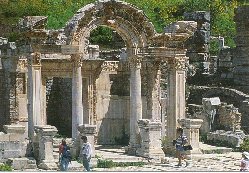 Temple of Hadrian |
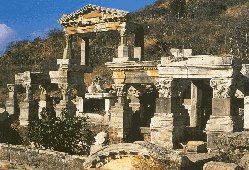 Fountain of Trajan |
Roman governors, politicians, and emperors all left their imprint on Ephesus. Both the great Roman Emperors Trajan and his successor Hadrian built monumental structures along Curetes Street. The Fountain of Trajan, erected in the 1st Century AD, had two stories decorated with twelve statues of Venus, Starun, Dionysus, and members of the Royal Family. The main statue showed the Emperor Trajan with his foot resting on the world, which was in the shape of a globe, proving that the Ancient Romans knew the true shape of the world even back in the 1st Century AD. The Temple of Hadrian was restored in AD 391 by the first Christian Emperor Theodosius and rededicated to his son, a general of the same name.
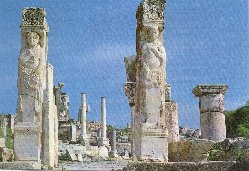 The Heracles Gate |
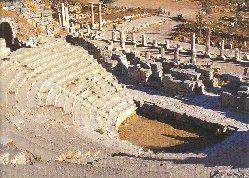 The Odeon |
The entrance to a side street leading to the city hall and Senate building leading off Curetes Street passes through the Heracles Gate decorated with twin statues of the mythical hero. The Senate Building, known as the Odeon, not only served as a meeting place for the governing body of the city, but also served as a smaller theater for musical productions and plays.
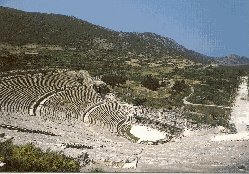 The Great Theater |
For larger productions and gladiator contests, the citizens of Ephesus used the Great Theater, build by the Emperor Claudius around AD 50 which seated 25,000 spectators, or the Ephesus Stadium which had a capacity of 13,000 people. From the seats of the Great Theater you had a spectacular view of the harbor of Ephesus, which today is completely filled in and 6 miles from the Aegean Sea. Harbor Street led from the Great Theater past the commercial Agora (marketplace) to the harbor that in ancient times was filled with ships from all around the Mediterranean Sea. It was lined with columns and paved with marble.
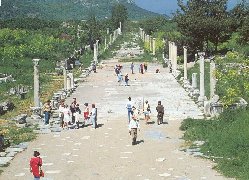 Harbor Street |
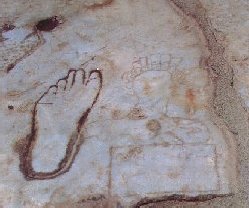 Harbor Street Street Sign on Marble |
At the harbor was the Great Harbor Gate and a large Roman public bath and pools. An interesting street sign can be found on one of the marble slabs on the street leading from the harbor to the main square. It shows the location of a brothel on the left "foot-side" of the road across from the Library of Celsus.
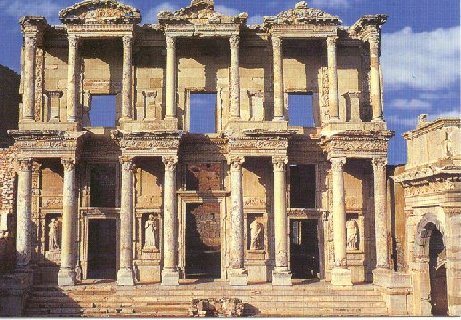 The Library of Celsus |
Probably one of the most impressive buildings left from Roman times is the Library of Celsus. It was built in honor of the General Governor of the Province of Asia in the year AD 135.
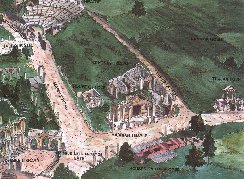 |
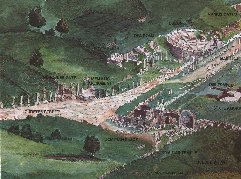 |
| sources: | anonymous. Ephesus. Istanbul: Keskin Color Kartpostalcilik, Ltd., 1999. |
| "Ephesus," Focus Online Magazine at http://www.focusmm.com/aceph_00.htm | |
| Tour Guide at Ephesus - July 13, 1999. |